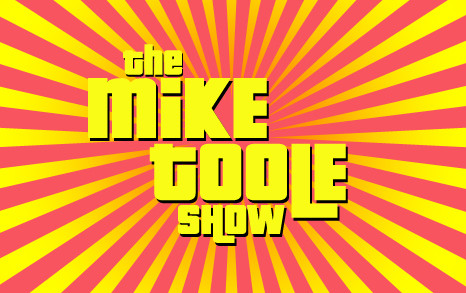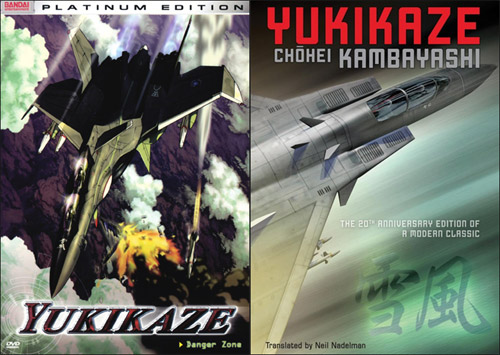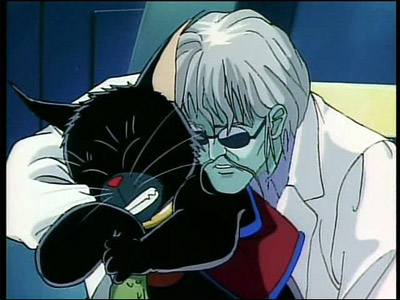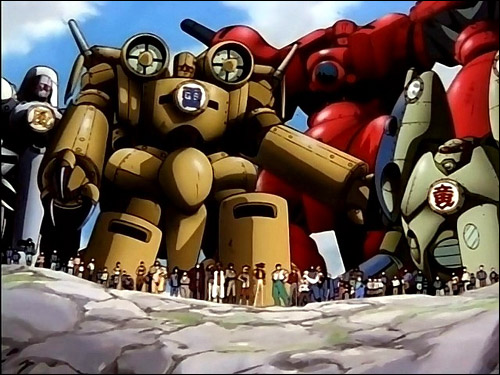The Mike Toole Show
Seiun, Say Me
by Michael Toole,
Remember going to see that first Harry Potter movie, and watching carefully to see what they left out of the books, only to fly into a table-flipping rage over their omission of Peeves the poltergeist? (Try watching that stinker again, I double-dare you!) How about the nerd fury over the crime-of-the-century omission of the great Tom Bombadil from the Lord of the Rings flicks? Yeah, “the book was better, man” has been a typical complaint about movies based on books, going all the way back to the film version of Margaret Mitchell's Gone with the Wind, James Whale's take on Mary Shelley's Frankenstein, and beyond, to the dawn of moviemaking itself.
But most anime isn't based on books, is it? Once anime made it to TV, the majority of the medium has either originated as manga, or was created specifically for animation. Nowadays, of course, more and more TV anime, such as fan favorites like Sword Art Online, Oreimo, and Fullmetal Panic, come from light novels. But the light novel adaptation trend is one that seems to have ramped up only recently; I wonder how much anime started as prestigious, well-regarded works of literary fiction?

The reason I've got the “books to anime” thought on the brain is because we're fast approaching the release date of Edge of Tomorrow, a new big-budget Tom Cruise action vehicle that's actually based on a Japanese science fiction novel, Hiroshi Sakurazaka's All You Need Is Kill. I read this book years ago because of its absolutely awesome title, and I wasn't disappointed—Sakurazawa's killer story concept comes off like a nutso SF version of Groundhog Day, and his narrative and dialogue are snappy and fast-paced. I'm not at all surprised it's getting made into a movie, because it was probably a really easy idea to sell to Hollywood.
Of course, a few things had to be changed to suit Hollywood. The book's protagonist, 20-year-old Keiji Kiriya, is replaced by the 51-year-old Tom Cruise. The plot has been rewritten to explain why a guy Cruise's age would be fighting on the front lines. Kiriya's foil, the skilled and deadly Rita Vrataski, has lost her lethal battleaxe in favor of a slightly less silly-looking sword. I'm sure there are other changes, but the fact is, the movie doesn't come out for another month. It actually looks like it might be pretty okay, despite the annoying title change (there's already an SF book called Edge of Tomorrow by some guy named Isaac Asimov; All You Need Is Kill is a bit clumsy, sure, but completely unforgettable). The inevitable media push has led to an interesting divergence, too—there's an official manga adaptation, and an official comic adaptation. You can see how they stack up below; the manga's on the left.

The manga is currently running in Shonen Jump; all by itself, that's a pretty good reason to subscribe to Shonen Jump (another good reason is One-Punch Man, the best currently-running comic in the world, in my opinion). It's adapted from Sakurazawa's book by Ryōsuke Takeuchi and Takeshi Obata—the latter name might ring a bell, if you're a Hikaru no Go or Death Note fan. It's gory, suspenseful, and highly enjoyable even if you've read the book; I'm gonna miss it when it wraps up, which shouldn't be too much longer. But hitting bookstores this week is All You Need Is Kill, a western comics adaptation by Nick Mamatas and Lee Ferguson. These types of weirdly divergent media fascinate me; it's kind of like stumbling across a paperback of Total Recall by Piers Anthony, based on the movie, which is based on Philip K. Dick's short story. A few sample pages of the comics have popped up, and they've got a rough-as-hell look to them that really contrasts with the manga. I have to admit, I'm a bit curious to read it. At any rate, Tom Cruise, who's staked his reputation as an actor and film producer on All You Need Is Kill, is confident enough in the film and its source material that he went back to the well and optioned Battle Fairy Yukikaze, the 1985 Seiun award-winning SF novel by Chohei Kanbayashi.
Does the name ring a bell? Bandai Entertainment released an OVA series entitled Yukikaze about a decade ago. It was notable for a few reasons. First of all, it was Bandai Entertainment's 20th anniversary project, for which they enlisted the help of the then-ascendant Studio Gonzo. Secondly, it features a really unconventional art style for fairly hard science fiction, with character drawings by versatile manga artist Yumi Tada. Finally, it had this really weird, tortured release schedule—disc 2 came out a good two years after disc 1, so fans had to wait quite some time to collect it all. The result is a bizarre, fascinating, and kinda disappointing adaptation of Kanbayashi's book.

I can actually speak authoritatively about comparing the two versions of the story, because we live in the future, where last week, I was able to think, “I should write about Yukikaze,” and buy the book in English with a single click. You can, too! It's a pretty damn fine book, actually. It's about a war between mankind and a mysterious alien race called the JAM (sadly, Paul Weller is not involved, so you can stop humming “A Town Called Malice,” please), but the war doesn't take place on earth—it takes place on the other side of an interdimensional portal, on a planet called Faery. Both mankind and the JAM have forward bases there, and constantly engage each other in a struggle for air superiority. Both forces favor dogfighting so much that there's hardly any combat on the ground. Two men involved in the war, pilot Rei Fukai and his commanding officer Jack Booker, start asking big questions: the human side increasingly depends on supercomputers to plan and fight the war against a shadowy alien race, so who's really fighting who? And back on earth, the situation is so remote that most of the public has forgotten it, with some starting to regard Faery's Special Air Force with as much suspicion as the JAM themselves. Even 30 years after its original publication, Kanbayashi's book is full of fresh ideas; it won the Seiun Award with ease, and 15 years later, its sequel, Good Luck Yukikaze, also won.
The anime version echoes its predecessor faintly, but is jarringly different. Rei's climactic air battle aboard the Yukikaze, his state-of-the-art Super Sylph fighter, takes place at the beginning of the OVA series. Rei himself is a near-silent cipher. In fairness, he's sort of a sociopath in the book, but he gets to have emotions and internal monologue. Very little of that is seen here, in favor of him sitting in near catatonia, while his war buddy Jack looks on adoringly. We might attribute this changed character relationship to the character designer Ms Tada, who also co-wrote the scripts and was working on a lot of shounen ai manga at the time. Entire story arcs, including a great piece about a beleaguered runway plow driver who unexpectedly gets a medal of valor, are axed for the OVA version. As the five-episode show grinds onward, freely grabbing elements from both the original book and Good Luck Yukikaze, we keep seeing scenes like this one.:

The more the camera dwells in Jack, the more it becomes obvious that Tada seems to have based his character design on Kurt Cobain (I feel like I've read an interview where she confirmed this, though I can't find it, so let's call it a theory of mine). Interestingly, Tada also created a set of six manga vignettes about Rei and Jack, including both exposition about their pasts and some details from the book that were omitted from the movie. As a bizarre capper to the whole anime adaptation, there's Rescue Me! Mave-chan, a 2005 OVA in which a boy named Rei is transported into a magical world where the planes from Yukikaze are actually cute girls. In this world, as long as people really love and believe in their favorite anime characters, they really exist! (I guess those otakukin folks were right all along.) The whole thing comes off as backdoor marketing for both Yukikaze and Stratos 4, which appears in the background a lot. It's a fascinating piece of the puzzle, just because it's so damned far from what Kanbayashi's original book was all about.
You might notice that I keep mentioning the Seiun Award. The Seiun is kind of like the Hugo Award, an annual prize awarded for the best in science fiction and fantasy. Just like the Hugo, the Seiun is focused on SF, and just like the Hugo, it's voted on and awarded at the annual big-deal science fiction convention—the Worldcon gets the Hugo, and the Japan Science Fiction Convention gets the Seiun. Western favorites like Arthur C. Clarke's Rendezvous with Rama (I totally almost typed Rendezvous with Ranma) have bagged the award, and mid-list authors like Greg Egan and James P. Hogan are favorites that have won again and again. Of course, the Seiun's biggest categories are for Japanese SF. Along with Yukikaze, the award's gone to Haruka Takachiho's Dirty Pair, Yoshiki Tanaka's Legend of the Galactic Heroes, and Kaoru Kurimoto's Guin Saga, so there's a bit of history there, of Japanese SF novels being mined for anime hits. But it's a pretty small bit.

One of my favorite of these bits? The Enemy is the Pirates, a six-episode OVA which also happens to be based on a Chohei Kanbayashi book that won the Seiun Award. Its story isn't too surprising, concerning a pair of bumbling space cops as they pursue a pirate intent on subverting some new experimental technology. The big comic twist is that one of those cops, Apulo, is a great big anthropomorphic cat. A walking, talking cat, who pigs out on junk food, talks trash, and attends to his duties with all of the focus and diligence of a housecat. The whole thing has that late-80s OVA eye-popping shine to it—it's directed by Katsuhisa Yamada, who also helmed fare like Outlanders and Record of Lodoss War. It features a booming heavy metal soundtrack, and even got a peculiar English dub for the UK, retitled Galactic Pirates. With that dub in mind, I'd say The Enemy's the Pirates! is a prime candidate for a license rescue by Discotek—even if some aspects of that dub are, ahem, ill-considered. (You know how Apulo is a black cat? Well, seems like the director went with "unfortunate stereotype" for the English language voice, and… yeah, pretty awkward.) Hopefully, Kanbayashi's Enemy is the Pirates books (there are a few of them) will get translated so we can compare them.

One name that sticks out at me on the list of Seiun Award Winners is Kishin Heidan by Masaki Yamada. Originally a 10-book series, it won the Seiun award in 1995, and had an anime adaptation that was damn near concurrent, starting in 1993. The 7-episode series, which has been released by Geneon under the titles Kishin Corps. and Alien Defender Geo-Armor, concerns the actions of a Brave group of freedom fighters locked in a struggle—as aliens use the chaos of World War II to invade, both the Third Reich and the Kanto Army try to steal their technology to make giant fightin’ robots with. Opposing them are the titular Kishin Corps, a multinational group of heroes with their own fightin’ robots. The OVA series is pretty fun, complete with cameo appearances from historical figures like Albert Einstein and Eva Braun, but it's got one well-known key difference—its young hero, Taishi Takamura, doesn't appear in the books. You know, having a special “movie only” character isn't that unusual—but the main character?!
What I've learned from pursuing All You Need Is Kill (which, it must be said, would make a great anime series!) and from reading the original Yukikaze novel is that Japan's science fiction is a bit sadly neglected, in terms of English translations. Sure, I've got the first two Yukikaze novels, but what about the third one, Unbroken Arrow? Heck, how about Heaven and Hell, Yasumi Kobayashi's winner from a couple of years ago? Viz's Haikasoru imprint is leading the charge for Japanese science fiction, with Hiroshi Yamamoto's MM9 and Toh Enjoe's Self-Reference ENGINE (remember the really funky Space Dandy episode with the books? Toh Enjoe wrote that!) on offer as well as Yukikaze, All You Need Is Kill, and many others. Yen Press are adding more light novels to their offerings, too.
Of course, perhaps it's a mixed blessing that there's only a limited amount of Japanese literary sci-fi and fantasy in English at the moment. In terms of prose, so much depends on a really good translator, and those are in short supply—both Hajime Kanzaka's Slayers books (with illustrations by Rui Araizumi) and Haruka Takachiho's Dirty Pair novels are written in first-person, from the perspective of a young woman. The English translations from Tokyopop and Dark Horse just didn't quite sell me on them. They were too dry to feel like internal monologues by bubbly redheads. Ever have that happen? In any case, I'm hoping that Tom Cruise's Yukikaze is a little more faithful to the original version. I'm not gonna hold my breath for that, though.
Do you track down and read the literary originals of some of your anime favorites? Do you dig on Hideyuki Kikuchi's creepily atmospheric Vampire Hunter D novels, or Nagaru Tanigawa's energetic Haruhi Suzumiya books? Share your favorites in the comments!
discuss this in the forum (25 posts) |